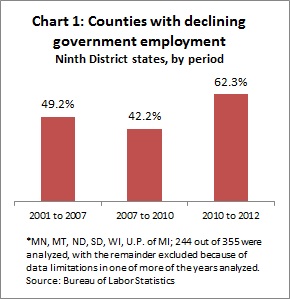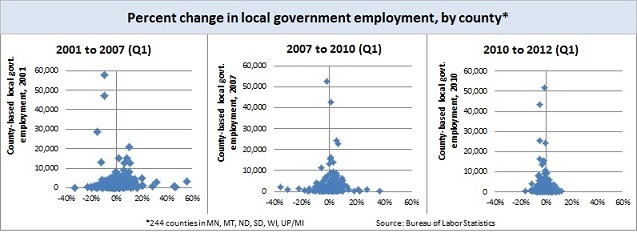Government jobs have long been known for their comparatively high job security. During and shortly after the recession, government employment actually rose slightly while private employment plunged (see previous blog post), thanks in large part to the federal stimulus plan that funneled billions of dollars to local and state government budgets to stave off further unemployment in the economy.
But with that stimulus gone, government employment has fallen by about 2 percent, or roughly 18,000 jobs, across Ninth District states from the first quarter of 2010 to the first quarter of 2012, according to data from the Bureau of Labor Statistics.
But there was considerable volatility in government employment even before the recession. An analysis of total government employment (federal, state and local) shows that almost half of the counties in district states saw a net decrease in government workers from 2001 to 2007 (see Chart 1). Some (unknown) portion of the decrease is likely due to the wind down of the 2000 decennial census; the number of federal workers dropped by almost 1,300 during this period while overall government employment rose by 12,300. About 85 percent of the job gains occurred in state government, where jobs are not as geographically widespread.

The federal stimulus temporarily pumped up government payrolls in the district, adding 18,000 net public workers from 2007 to 2010, half of them at the local level. But once the stimulus funds ran dry, the pink slips came out. By the first quarter of 2012, district states had shed almost 19,000 government jobs, about two-thirds of which were local government workers; another one-quarter of losses were federal workers, likely the result of another census winding down. Job losses were seen in 62 percent of district counties analyzed (see note at end).
The past two years have been particularly rough on counties with large employment bases, with all of them seeing at least a nominal decline in the most recent period (see Chart 2, right-most panel). But many saw earlier cutbacks, and some even declined in spite of stimulus funds (see other two panels). Many of these larger counties are in Minnesota and Wisconsin, where state and local budgets have been see-sawing since the 2001 recession. Larger counties in the Dakotas and Montana generally fared better in terms of government employment, in part because they are seeing strong population growth, which tends to induce more government services and subsequent employment.
Much more on local government budgets and employment will follow in the forthcoming January fedgazette.

(One methodological note: County-level data can be hit or miss for a given quarter, particularly among smaller counties. Almost one-third were missing valid counts in one or more of the dates analyzed. As a result, the scatter-plot analysis above includes 244 out of a possible 355 counties in the Upper Peninsula of Michigan, Minnesota, Montana, North Dakota, South Dakota and all of Wisconsin, only the northwestern one-third of which is part of the Ninth District.)
Ron Wirtz is a Minneapolis Fed regional outreach director. Ron tracks current business conditions, with a focus on employment and wages, construction, real estate, consumer spending, and tourism. In this role, he networks with businesses in the Bank’s six-state region and gives frequent speeches on economic conditions. Follow him on Twitter @RonWirtz.





